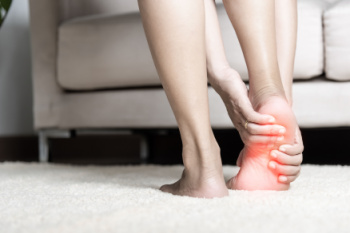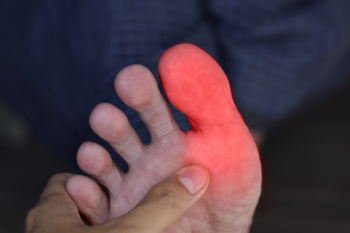
Diagnosing heel pain in adults starts with a detailed history and physical exam. A podiatrist will ask about when the pain started, what makes it worse, and if it is sharp, dull, or burning. Common causes include plantar fasciitis, Achilles tendinopathy, or heel spurs. The location of the pain, bottom, back, or sides of the heel, can offer important clues. Your doctor may check your gait, foot alignment, and flexibility. In some cases, imaging tests like X-rays or ultrasounds are used to look for structural problems or soft tissue injuries. Blood tests might be done if an inflammatory condition is suspected. Early diagnosis is key to effective treatment and can prevent chronic discomfort. If heel pain is interfering with your routine or worsening over time, it is suggested that you see a chiropodist for relief options
Heel pain is a common problem that can be caused by a variety of injuries, medical conditions, and other factors. If you suffer from heel pain, please consult with one of the chiropodists from Complete Family Footcare & Therapy. Our clinicians can help you maintain the health of your lower limbs and your mobility.
When it comes to heel pain, the exact location and type of pain are important to note. Some of the conditions that may cause heel pain include:
Plantar fasciitis - An inflammation of the ligament that runs along the bottom of the foot; it causes a stabbing pain under the heel that is at its worst when taking your first few steps after a long rest and while standing on your tiptoes or climbing stairs
Achilles tendonitis - An inflammation of the tendon in the back of the calf; it causes pain in the back of the heel that is at its worst after resting, as well as ankle and calf stiffness, swelling, and tenderness
Bone spurs - Bony lumps on the back of the heel bones that cause sharp pain upon first standing up; the pain becomes dull and achy over time
Heel fractures - A break or crack in the heel bone that causes pain, swelling, and difficulty walking
Retrocalcaneal bursitis - Swelling of the small, fluid-filled sac at the back of the heel bone; it causes pain, swelling, redness, and warmth in the back of the heel
Tarsal tunnel syndrome - Compression of the posterior tibial nerve which causes a pins and needles sensation in the heel, foot, and calf
Your chiropodist will be able to diagnose the underlying cause of your pain and prescribe the right treatments for you. If you have any questions, please feel free to contact our offices located in . We offer the newest diagnostic and treatment technologies for all your foot care needs.

A foot infection can develop due to bacterial exposure, poor hygiene, or underlying health conditions. Bacterial infections often arise from cuts, blisters, or ingrown toenails that allow germs to enter the skin. A compromised immune system increases susceptibility, making it harder for the body to fight off infections. Poor foot hygiene, including excessive moisture and unclean footwear, creates an environment where bacteria thrive. Symptoms of a foot infection include redness, swelling, warmth, and pain in the affected area. In more severe cases, pus drainage, foul odor, and difficulty walking may occur. If left untreated, infections can spread and lead to more serious complications. If you have any of the above symptoms, it is suggested that you promptly schedule an appointment with a chiropodist who can help you to manage foot infections.
Foot pain can have many causes. To receive an accurate diagnosis and treatment for your foot pain, please consult with one of the chiropodists from Complete Family Footcare & Therapy. Our clinicians will assess your condition and provide you with quality foot and ankle treatment.
Causes
There are a variety of different conditions that can cause foot pain, including:
Plantar fasciitis
Deformities, such as bunions or hammertoes
Injuries to the muscles, bones, tendons, or ligaments in the feet
Arthritis
Flat feet
Ingrown toenails
Symptoms
The type and location of your foot pain can help determine what may be causing it and what type of treatment options are best for you.
Common types of foot pain include:
Heel pain
Arch pain
Toe pain
Ball of foot pain
Pain that has a stabbing, burning, or tingling quality
Pain that is constant, intermittent, or that gets better or worse depending on the situation
Diagnosis
A thorough medical history and physical examination of your feet will be required to determine a diagnosis. Imaging studies, such as X-rays or MRIs may be performed to rule out or confirm certain diagnoses.
Treatment
Treatment will depend on the cause of the pain. Common treatments for foot pain include resting, icing, compressing, and elevating the affected foot, wearing orthotics, or taking anti-inflammatory medications.
If you have any questions, please feel free to contact our offices located in . We offer the newest diagnostic and treatment technologies for all your foot care needs.

Hallux rigidus is a form of arthritis that affects the big toe joint, causing stiffness, pain, and reduced range of motion. It typically develops gradually, and is most noticeable while walking, running, or standing for long periods. Over time, the joint may become swollen or develop a bone spur, further limiting movement and making wearing shoes uncomfortable. This condition is often caused by wear and tear on the joint, previous injury, or abnormal foot structure. Orthotics can play a key role in managing hallux rigidus by reducing joint stress, improving foot alignment, and helping limit painful motion. Stiff-soled shoes or rocker-bottom soles may also help ease discomfort during walking. While non-surgical treatments can provide relief in many cases, more advanced stages may require other interventions. If you are experiencing persistent pain or stiffness in your big toe, it is suggested that you see a chiropodist who can evaluate your condition and suggest the best course of care, which may include custom orthotics.
Toe pain is common and can have a variety of causes. Causes can range from a broken toe to an ingrown toenail. Many types of toe pain can be corrected, but any toe pain that inhibits your activities for an extended period should be discussed with a chiropodist. If you suffer from toe pain, please consult with one of the chiropodists from Complete Family Footcare & Therapy. Our clinicians can help you maintain the health of your feet.
Common Causes of Toe Pain
- Trauma or fracture
- Cuts, sores, or bruises
- Rheumatoid arthritis
- Gout
- Turf Toe
- Morton’s neuroma
- Blisters
- Corns
- Bunions
- Hammertoes
- Ingrown toenails
- Plantar warts
- Athlete’s Foot
Symptoms of Toe Pain
- Toe deformity
- Burning
- Numbness
- Toenail deformity
- Wart or ulcer
- Swelling
- Redness
When to See a Chiropodist
- Bleeding or severe swelling
- Trauma, such as a broken bone
- Discoloration or extreme swelling
- Inability to bear weight
- Persistent pain
- Wounds that won’t heal
Diagnosis of Toe Pain
A chiropodist can conduct a thorough examination of the painful toe or toes in order to determine the best course of treatment. The exam may include assessing the tenderness of the area, taking an X-ray or other diagnostic test, or assessing your gait and range of motion. A discussion of what led to the advanced pain issue may follow. Included will likely be a health history, as well as a list of medications you are taking and other previous injuries you may have sustained.
Treatment for Toe Pain
With such a wide range of possible causes for toe pain, treatment can be varied in scope and length. Sometimes, the chiropodist will recommend lifestyle and activity changes. In cases of trauma or other injuries, X-rays or imaging tests will likely be used to determine the severity of the problem, particularly if any bones have been broken. Treatment may also include injections of pain-relief medication or anti-inflammatory drugs. Certain injuries will require the splinting, bracing, or wrapping of injured toes. Orthotics or special shoes may be prescribed in cases of bone deformities and gait issues. Removal of warts, calluses, and corns may be needed. In other cases, such as with patients who have diabetes or rheumatoid arthritis, ongoing treatment may be required to avoid more serious problems.

